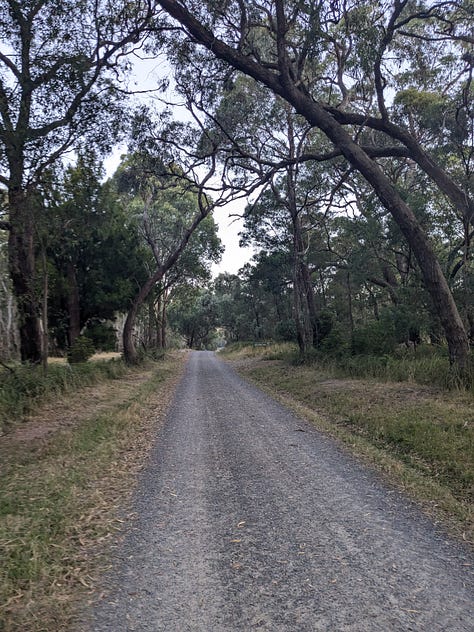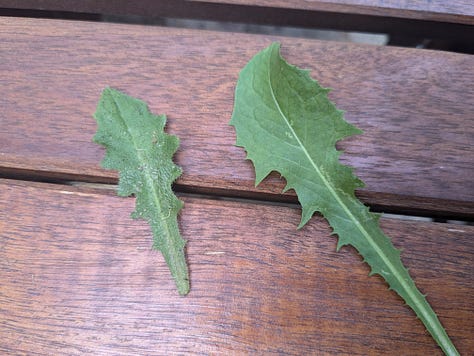Welcome to the second ever edition of The Nature Enthusiast!
This week I am enthusiastically reviewing the extended lake circuit trail of Lysterfield park, and helping you to identify flatweed!
The route
Overview: A fairly easy 7.7 km loop with 121 m of elevation gain around Lysterfield lake. (Find the route on Strava here)
Where to go: Starting at the Mahagony car park, head north on the Lake circuit trail. You’ll be on a fairly narrow trail that includes a board walk. At the end of this section of trail, move onto the large Logan park track. Follow it north until the equally wide Lamberts track. Both of these tracks are not particularly scenic, but offer great opportunities to see kangaroos and even wallabies grazing in the open areas. Hot tip: the kangaroos at Lysterfield are generally pretty hard to spook, but if you make a point of not looking directly at them they’ll let you get really close without hopping away (to the point that you could easily touch them… but don’t!). Follow the track up and then down the hill, turning left onto the Casuarina track. You’ll get nice and close to the lake, before going back up the hill (sorry!) onto the Cloverdale track. You’re almost guaranteed to find kangaroos on this track again, especially if you’re out in the early morning. Go all the way until you hit the end of the park, then turn left onto the West Boundary track. Along this track you’ll get a lot of house envy (living right next to a great park! Tennis court in your backyard! Yes please!), lots of spotted gums, and no great views despite being at the highest elevation of your loop. Then just before you hit a carpark (where you’re not allowed to park… it’s confusing), turn back onto the Casuarina track before turning right onto the Lake circuit track and going over the dam wall. Great views incoming. Follow this trail all the way back to the carpark (after a dip in the lake if you need to cool off). Toilets and a water fountain are available at the start/end of your loop.



Trail conditions: Apart from the trail and boardwalk at the beginning, all the trails are wide and smooth enough for park maintenance vehicles to drive over. Some are even paved!
Wildlife: Eastern grey kangaroos everywhere! You win if you spot a swamp wallaby. Magpies, noisy miners, crimson rosellas, ducks, swamp hens, and more. Humans abound on the main lake circuit trail, and you might even spot some mountain bikers.
Other considerations: Lysterfield park is exceptionally busy. If you prefer your runs/walks/hikes to be a solitary event, your best bet is starting before 7 am or only going out on in bad weather. If 7.7 km and 121 m of elevation gain is a bit much for you, you can stay on the main lake circuit trail. It’s flatter and shorter, but also busier and with less kangaroo spotting opportunities.
Flatweed (Hypochaeris radicata)
Overview: A common backyard weed, I’d be surprised if you can’t find one on a short walk through your neighbourhood. On first glance, you probably mis-named it a dandelion, because they do look similar. Both have happy yellow flowers made of dozens of overlapping petals, tufty parachutes of seeds, and indented leaves. But there are differences.



Leaves: Flatweed (on the left in the above photo) is roundly indented, as opposed to the sharp teeth of dandelions. Flatweed leaves are often hairy (if you find a flatweed that doesn’t have hairy leaves, you’ve found it’s cousin - cat’s ear Hypochaeris glabra).
Stalks: The stalks are smoother and skinnier on flatweed, but the biggest giveaway is that flatweed stalks may be branched. Dandelion stems are never branched, are hollow, and often have a purple tinge.
Why it’s cool: Flatweed is entirely edible! The leaves can be tossed in a salad, sauteed with oil and garlic, or added as the greens in a weed pie. The flowers can be infused in honey or added to muffins and shortbread for a light floral note. The root can also be used as a coffee substitute (don’t ask me how to prepare it though, I’m not a coffee drinker). And the best part is that you can’t accidentally poison yourself by engaging in bad novice foraging! Dandelions are also entirely edible, as is sow thistle (which also has the yellow flower and indented leaves - the key identifying characteristic of sow thistle is that the leaves grow up the stem).
Flatweed is a great introduction to foraging and weed identification. You’ll feel pretty smart when you first realise you can tell the difference between flatweed and it’s lookalikes, and you can start experimenting with eating foraged food without worrying too much about a poor identification!
That’s it for this month! Subscribe so you don’t miss next month’s trail review, and leave a comment if you’ve done this route before or have spotted a flatweed in your own neighbourhood!





